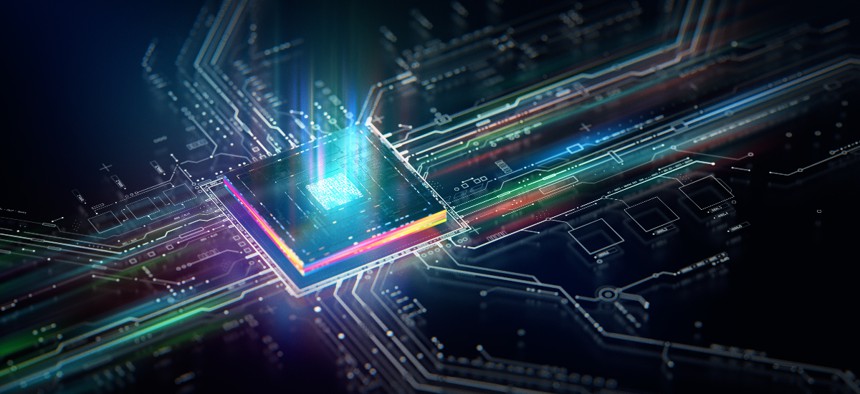NASA Quantum Detector Could Help Expand Transmission Distance

da-kuk/Getty Images
Current quantum data deteriorates after a few dozen miles, but the new technology could send more data further.
A new NASA quantum detector could help improve how far away quantum computers exchange data, according to an announcement last week.
The Performance-Enhanced Array for Counting Optical Quanta, PEACOQ, detector—developed by NASA’s Jet Propulsion Lab and the California Institute of Technology—can count large numbers of single photons, or quantum particles of light, with great precision. Specifically, it can “measure the precise time each photon hits it, within 100 trillionths of a second, at a rate of 1.5 billion photons per second”—a rate no other detector has achieved, according to the announcement.
“Transmitting quantum information over long distances has, so far, been very limited,” said PEACOQ project team member Ioana Craiciu, a postdoctoral scholar at JPL and the lead author of a study describing these results. “A new detector technology like the PEACOQ that can measure single photons with a precision of a fraction of a nanosecond enables sending quantum information at higher rates, farther.”
Traditional computers transmit data through modems and telecommunications networks by copying the information as a series of 1s or 0s, called bits, which are then transmitted through cables along optical fibers, then through space via light flashes or radio wave pulses. Once received, the bits are reassembled to recreate the original data.
However, quantum computers encode information as quantum bits, or qubits—data encoded with quantum physics principles—which “can’t be copied and retransmitted without being destroyed,” the announcement noted. In addition to that challenge, qubits require special fiber optic cables that have demanding hardware needs and limit the distance qubits can actually travel. According to the announcement, quantum information sent via optical fibers “degrades after just a few dozen miles,” limiting the network size. But the new detector could enable quantum computers thousands of miles apart to exchange data.
“In the near term, PEACOQ will be used in lab experiments to demonstrate quantum communications at higher rates or over greater distances,” Craiciu said. “In the long term, it could provide an answer to the question of how we transmit quantum data around the world.”
The detector is small, measuring 13 microns—which are one-thousandth of a millimeter— across. It must be kept one degree above absolute zero, or minus 458 degrees Fahrenheit, to keep the nanowires in a superconducting state—necessary for the nanowires to turn the absorbed photons into electrical pulses delivering quantum data. According to the announcement, while the detector must be sensitive for single photons, it is designed to be able to have multiple photons hit it at once. When one nanowire is hit by a photon, it cannot detect another photon for a period of time—“dead time”—which NASA worked to make as short as possible. The detector is composed of 32 niobium nitride superconducting nanowires on a silicon chip with connectors fanning out; each nanowire is 10,000 times thinner than one human hair. It has these 32 nanowires so “others can pick up the slack while one is ‘dead,’” the announcement stated.
The detector is funded by NASA’s Space Communications and Navigation program within the Space Operations Mission Directorate and built by the Microdevices Laboratory in JPL. It is part of the agency’s effort to promote free-space optical communications between space and the ground. The PEACOQ detector is based on the detector for NASA’s Deep Spatial Optical Communications technology demonstration, which will commence with NASA’s Psyche mission later in 2023. That mission is intended to demonstrate how high-bandwidth optical communications between Earth and deep space could work. While the Deep Space Optical Communications will not be using quantum information, it needs the same “extreme sensitivity” to count single protons.
“It’s all kind of the same technology with a new category of detector,” said Matt Shaw, who leads JPL’s superconducting detector work. “Whether that photon is encoded with quantum information or whether we want to detect single photons from a laser source in deep space, we’re still counting single photons.”






